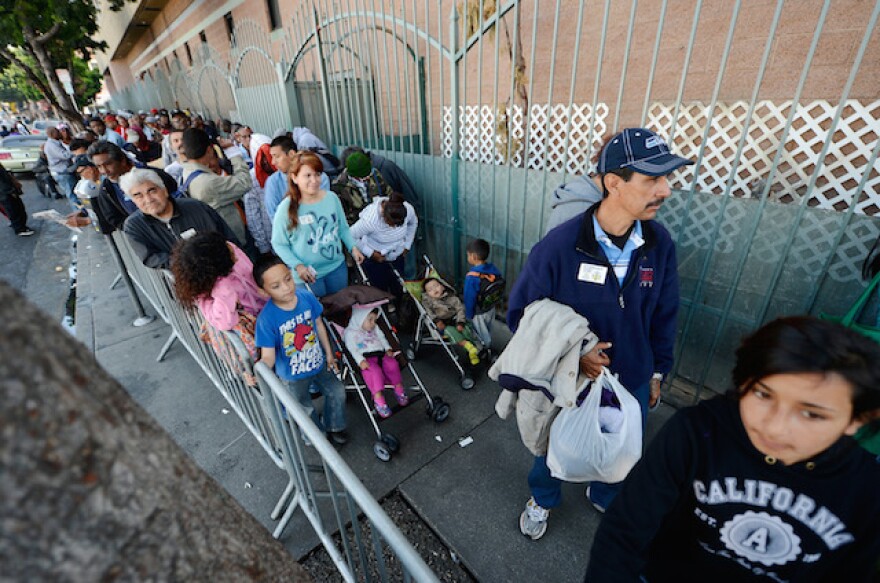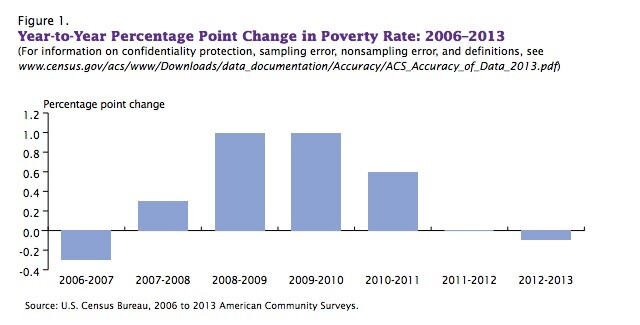With our free press under threat and federal funding for public media gone, your support matters more than ever. Help keep the LAist newsroom strong, become a monthly member or increase your support today.
This is an archival story that predates current editorial management.
This archival content was written, edited, and published prior to LAist's acquisition by its current owner, Southern California Public Radio ("SCPR"). Content, such as language choice and subject matter, in archival articles therefore may not align with SCPR's current editorial standards. To learn more about those standards and why we make this distinction, please click here.
Los Angeles Is The Poorest Big City

There are new stats out showing that the Los Angeles area has the highest poverty rates of the biggest cities.
The American Community Survey numbers put out by the Census Bureau looked at poverty in 25 major metropolitan areas in 2013. The Los Angeles-Long Beach-Anaheim area had 17.6 percent of people living under the poverty line. The area that had the highest rate of all the areas were our neighbors to the east: Riverside-San Bernardino-Ontario had 18.2 percent of its residents living under the poverty line. Miami-Fort Lauderdale-West Palm Beach also had slightly more than us with 17.7 percent. We tied with Phoenix-Mesa-Scottsdale.
But among the biggest cities, we're at the top. The rate in New York-Newark-Jersey City was 14.6 percent, in Chicago-Naperville-Elgin it was 14.4 percent and Washington-Arlington-Alexandria was the least-impoverished of all 25 areas with 8.5 percent living under the poverty line. Up in San Francisco-Oakland-Hayward the rate was 11.5, and down in San Diego-Carlsbad the rate is 15.2. California's rate overall was 16.8 percent.
And of course, any time we talk about poverty in California, it's important to note that the situation is probably worse than it sounds. The poverty line is the same—$23,550 for a family of four—whether you're talking about Wyoming (which actually had the lowest poverty rate of the states at 10.6 percent) or a notoriously expensive city like San Francisco. These numbers from the census don't seem to take the varying costs of living in different cities and states into account.
“We find that Los Angeles stands out even more, unfortunately," Sarah Bohn, a researcher at the Public Policy Institute of California, told KPCC. "Housing costs are really playing a big role in family budgets and being able to make ends meet.”
Our median household income in the Los Angeles area was $58,869 in 2013. Incomes in the Los Angeles are rose $804 from the year before, but we're still $1540 behind 2010 levels.
The number that worries Marybeth Mattingly, a researcher at Stanford University’s Center on Poverty and Inequality, is the rising child poverty rate. It was 25.3 percent in 2013, which is up from 22.6 percent in 2010. Mattingly said, "These numbers paint a bleak picture for California."
There's not really any kind of silver lining but the not-quite-good news from the Census is that overall poverty rates didn't change much around the country and actually went down a bit. But this comes after four years of the poverty rate ticking up and one year of the rate stabilizing:

The change in poverty rates year by year (Census)
If you want to take the really long view, other stats show that the number of people in poverty in Southern California has grown 69 percent since 1990, while the population has only grown 26 percent during that time.
It looks like Mayor Eric Garcetti has some new cold hard numbers that make the case for raising the minimum wage here.







